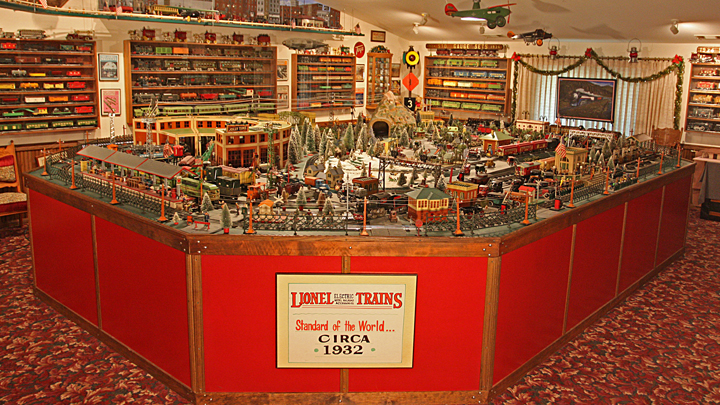|
As most of us have homes to return to at night, so must the steam engine return to the Roundhouse. This section of five stalls was produced in 1932 to 1934 by the Lionel Corporation and sold for $12.50 a stall. In 1932, that was a lot on money for an accessory that would take up so much room that the turntable had to be made small enough that most steam engines produced at that time would not fit on the table with their tender.
|

|
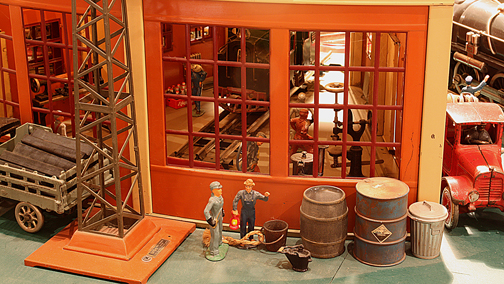 |
Look inside one of the round house stalls and you will see the tools and activities that keep the steam engines running. Toward the left inside you will see a lathe while on the right, and an industrial drill press on the left. You just don't order a replacement parts on a steam engine, you have to manufacture a new part, or repair the old part. The fire box needs continue cleaning; as do the tubes which carry the boiling water which creates steam pressure frequently need to be replaced. With so many workers in the round house you might need a Coke machine to refresh the workers. Many of the tools are miniature German made models of real ones.
|
|
Behind the Round House we find a Boy Scout camp out. They are working on five different Merit Badges: Hiking, Cooking, Camping, Signaling, and Citizenship. To represent the time period of the layout the Signaling Merit Badge uses Semaphores Flags (such as those used on Naval Ships). How would you like to camp in the woods near an operating Round House? Patrol leaders and Assistant Scoutmasters all develop leadership skills needed in almost every job to include working as the foreman in a Round House.
|
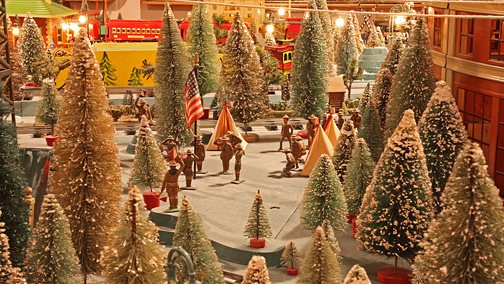
|

|
To be able to run a toy train in the early part of the century, you needed to be an "electrician of sorts" in order to get all of the wires to work the switches and set the proper voltages to use accessories and operate trains. What a start for a young person to learn these skills while at play. The Great Train Room uses over a dozen rheostats to control the speed (voltage) of the trains... just the way a young person would have had to do it in 1932.
|
|
Lionel learned that after the Christmas season, kids (and their parents) would purchase accessories for the trains that arrived on the 25th of December. This picture shows the largest of the three power houses Lionel produced as extra accessories. In all three cases, the power houses would "hide" a transformer which of course was required to run the trains and lights on the layout. Two large K-Transformers could be concealed under the two wings of the power house.
|
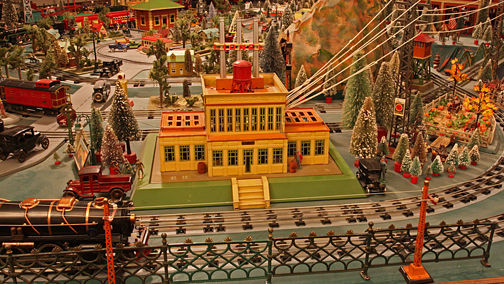
|
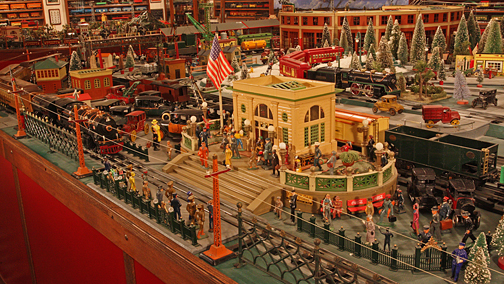 |
One of the finest train stations Lionel made for Standard Gauge trains was the #128 Station and #129 Terrace with landscaped plots on each end and elegant railing with supported lamppost. Finding figures to represent travelers, train men, and general folks is a challenge that most builders of model layout put off until one of the last actions to "complete the layout". The combination station is 31-1/2 inch wide and 18 inches deep.
|
|
This next picture you will see Dick Tracy and Breathless Mahoney (aka-Warren Beatty and Madonna) are about to board a train. Dick Tracy is checking his watch since he knows that trains are always on time! Waiting next to the station is a group of Arcade Taxi Cabs waiting to pick up travelers as they disembark from the Transcontinental Limited (Lionel's Brown State Set).
|
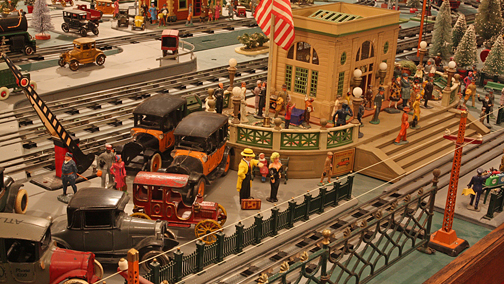
|

|
Three #155 Freight Sheds round out the utilitarian concept of a working layout, after all, while passenger traffic may have been the reason travelers liked to travel by train (until the trend of flying in airplanes slowly eroded the numbers of train travelers) there was always freight that needed to be transported as many families were hearing the call of "Go West young man to find your fortune!".
|
|
This scene shows the river channel under Lionel's two: "Hell Gate" bridges... the very same one that connects Manhattan to Brooklyn as it crosses over the East River. The real bridge was finished just three days before America joined the allies in WWI (1917). Lionel introduced the bridge as an accessory starting in 1928 and remained until 1941. This toy bridge is an example of the craftsmanship that went into building Lionel toys.
|

|
| |
